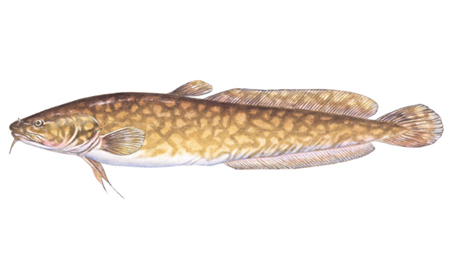Common Names: Burbot, ling, eelpout, lawyer, freshwater cod, maria
Habitat
Widely distributed across most coldwater bodies throughout the province. Burbot are usually found only in the deepest parts of the lake. They are rarely found in shallow waters, except during spawning or possibly through the night when feeding. In the far north, where water temperatures are cold year-round, their habitat may extend into the shallow waters of tributary rivers.
Spawning Patterns
Burbot spawn through the winter under the ice (which is rare). Depending on how early the lake freezes, this has been recorded as early as November but usually occurs between January and March. This period is one of the only times when burbot can be found in shallow water. Spawning occurs in shallow bays or shoals on sand or fine gravel in depths between 1 and 4 feet. Spawning only occurs at night and involves several individuals intertwined in a large ball.
Diet
Small burbot feed mainly on aquatic insects while larger fish feed almost exclusively on other fish species like walleye, cisco, perch, smelt and sculpins (depending on what is most readily available). Cisco eggs have also been noted to be an important dietary item where available.
Age and Size
The burbot’s most rapid growth occurs during the first four years of its life, growing to an average length of around 50 cm (19”). The fish continue to grow as they get older but at a much slower rate. The average life expectancy is suspected to be between 10-15 years.
Fishing Tips
Most burbot are caught accidentally by anglers who are fishing for other species, such as lake trout. A large portion of the harvest is by winter lake trout anglers. The most effective way to catch burbot is to fish directly on the bottom during the evenings through the ice with small minnows. During the open-water season, concentrate on the deeper parts of the lake and fish directly on the bottom using minnows.
Fish illustration ©CURTIS ATWATER (www.natureartists.com/atwaterc.htm)










